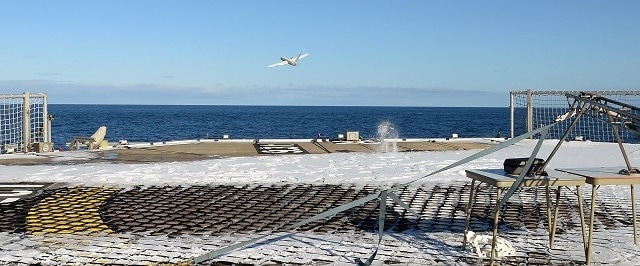Apr 19 2016
The Royal Navy has launched a miniature pilotless aircraft from its ice patrol ship HMS Protector, developed by researchers at the University of Southampton. This was the first time such an unmanned aerial vehicle has been put into use by the Royal Navy to aid navigation through the Antarctic.
 SULSA launching from HMS Protector
SULSA launching from HMS Protector
The 3D-printed aircraft, in addition to a quadcopter, patrols the path taken by the survey ship so that it can find its way via frozen seas.
Over the past few years, the Royal Navy has deployed ScanEagle ‘eyes in sky’ from warships in the Gulf. This was done to provide crucial live imagery to the ships on maritime security patrols.
Although smaller in size and less hi-tech, the unmanned aircraft was able to offer the icebreaker with superior quality data in real time, thanks to the comprehensive image of the surrounding environment obtained from a viewpoint that is only possible from the air.
The 3D-printed miniature aircraft was launched off on longer patrols, and the quadcopter can be used for short-distance reconnaissance missions.
The Laser-Sintered Aircraft, dubbed SULSA and developed by the researchers at the University of Southampton University, is made up of nylon and 3D printed in four key components that can be assembled without using any tools. It is the first ‘printed’ airplane in the world. It can be controlled from the ship using a laptop. The airplane travels at about 60 mph, and is almost noiseless as it has a very small engine. The costs to create the entire aircraft does not exceed £7,000, which is cheaper than one hour’s flight using a Fleet Air Arm helicopter.
Last summer, this 3 kg aircraft was tested off the Dorset coast from the HMS Mersey. The aircraft went through further rigorous testing over the Antarctica. The flight duration was up to 30 minutes, and then a boat from HMS Protector was sent out to collect the aircraft from the water for a subsequent re-launch.
The vehicle captured the spectacular video imagery of the Antarctic seas. The operation of the aircraft was performed safely and reliably under the supervision of Andrew Lock from the University’s Computational Engineering and Design research group.
This trial of these low-cost but highly versatile aircraft has been an important first step in establishing the utility of unmanned aerial vehicles in this region. It’s demonstrated to me that this is a capability that I can use to great effect.
Captain Rory Bryan, Protector’s Commanding Officer
The series of flights conducted by Southampton staff in conjunction with the Royal Navy from HMS Protector has been a great success. These flights have shown just what can be achieved with smart design and low cost digital manufacture.
Andy Keane, Professor of Computational Engineering, University of Southampton
The results from the trial run performed from the Protector have been transmitted to the headquarters of the Royal Navy in Portsmouth - 700X Squadron in Culdrose – which is the Navy’s exclusive unmanned aircraft unit, and to the Maritime Warfare Centre at HMS Collingwood. In this project, Andrew Lock received support from Lt Cdr John Breen, who is the Trials Management Officer from 700X.
I am delighted with the successful deployment of small unmanned aerial vehicles from HMS Protector in the Antarctic. The whole team has overcome significant hurdles to demonstrate the enormous utility of these aircraft for affordable and persistent surveillance and reconnaissance from ships – even in the environmentally challenging environment of the Antarctic. Although this was a relatively short duration trial to measure the relative merits of fixed and rotary wing embarked systems, we are continuing to review our options for acquisition of maritime unmanned aerial vehicles in the future.
Commodore James Morley, Assistant Chief of Staff Maritime Capability, The Navy